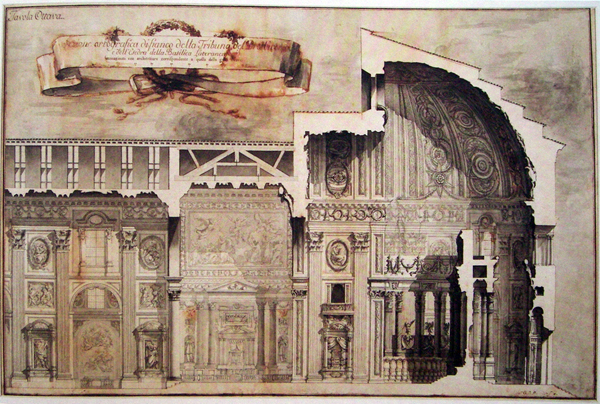
Piranesi's etching of the San Giovanni in Laterano interior
The vedute of Giovanni Battista Piranesi tend to make quite an impression on their beholders, but they are not only lauded for their artistic qualities. Embedded in the heated architectural debates of the late 1750s and early 1760s, Piranesi was actively engaged in providing proof for his claims about the grandeur of Rome, both in its ancient and modern incarnation. The vedute can be seen as part of this debate. In this light, they present themselves as vehicles of knowledge, more in particular as reproductions of truthful experiences as one might encounter them in eighteenth century Rome.
This study tries to shed light upon one of these vedute, the interior of the San Giovanni in Laterano. The etching, presumably made in the 1760s, depicts the nave of the church as a grand gesture of movement towards the apse. Not coincidentally, Piranesi was involved in a renovation project for the apse of the same church. It was one of the two architectural commissions he received, and perhaps the most important one of the time.
Piranesi searched in his vedute for knowledge to exemplify the illustrious history of Rome and to support his theories on architectural innovation. He was fully aware of the fact that both his fantastical license and his reason to creation needed back up from acknowledged sources. For him, those sources were archaeological: as the ancients applied variation and searched for improvement, so could the moderns.
In his architectural practice Piranesi consciously applied his knowledge of history to improve his architecture. He adorned both the project for the Santa Maria del Priorato and the San Giovanni in Laterano with historical references, combined iconographical sources and established an intriguing all-embracing, but utterly subjective design scheme.
Piranesi chose a particular way of depicting the interior of the San Giovanni in his etching. This specific viewpoint invokes questions, because it does not pay direct tribute to the liturgical content of the church, which is most prominent in the nave clementina. It does, however, focus on the for Piranesi significant aspects of the church: the apse, its lightness and the passage towards it. Piranesi even strengthens this image by carefully adjusting the perspective of the etching. His view on the church was far from utopian and his use of this vedute far from fantastic his was a conscious endeavour to illuminate the ideas he set out in his own architectural schemes.

Longitudinal section of the second design set for the choir of San Giovanni in Laterano
